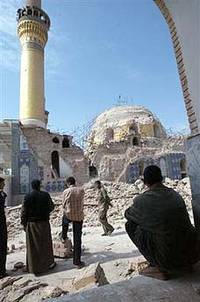Iraqi World Heritage
UNESCO is preserving and rehabilitating four major cultural sites in Iraq.
UNESCO’s World Heritage mission is to help State Parties safeguard World Heritage properties and encourage international collaboration in the conservation of our world’s cultural and natural heritage. So far, with UNESCO’s support, four Iraqi sites have been inscribed on the World Heritage List. Moreover, UNESCO is providing assistance for the regular update of Iraqi Tentative List for World Heritage. The four current Iraqi World Heritage Sites are, as follows:-
Erbil Citadel
The Citadel of Erbil is a rich historical repository holding evidence of many millennia of habitation; more than 8000 years old, it is the longest continuously inhabited site in the world. This longevity was made possible by the existence of abundant ground water, which has sustained the population throughout its long history. The Citadel rises 28-32 m above the surrounding city and overlooks the wheat fields which extend all the way to the Greater Zab River thirty kilometres to the west. The mound has been formed by successive layers of settlements: Assyrian, Akkadian, Babylonian, Persian and Greek.
Erbil Citadel is the fourth site from Iraq to be included in the World Heritage List, after Ashour, Hatra, and Samarra Archeological city. It was inscribed during the World Heritage Committee meeting in June 2014, in Doha, Qatar.
Ashur (Qal’at Sherqat):
The ancient city of Ashur is located on the Tigris River in northern Mesopotamia at the borderline between rain-fed and irrigation agriculture. The city dates back to the 3rd millennium BC. From the 14th to the 9th centuries BC Ashur was the first capital of the Assyrian Empire, serving as a city-state, trading platform and religious capital associated with the God Ashur. The city was destroyed by the Babylonians, but revived during the Parthian period in the 1st and 2nd centuries AD. The site was inscribed on the World Heritage list in 2003 – also placed on the World Heritage List in Danger because of its dire need for protection after the start of the war.
Samarra Archaeological City:
The Archaeological City of Samarra is the site of a powerful Islamic capital city which ruled over the provinces of the Abbasid Empire extending from Tunisia to Central Asia for a century. Located on both sides of the River Tigris 130km north of Baghdad, the length of the site from north to south is 41.5km. Unlike other great capitals that prospered and led to the loss of their early remains, Samarra was rapidly abandoned and thus much of its plan and architecture are preserved. Samarra Archaeological City was inscribed both on the World Heritage List and on the List of World Heritage in Danger in 2007.
Hatra:
The archaeological city of Hatra was nominated for the World Heritage list in 1987. A large fortified city under the influence of the Parthian Empire and capital of the first Arab Kingdom, Hatra withstood invasions by the Romans in A.D. 116 and 198 thanks to its high, thick walls reinforced by towers. The remains of the city, especially the temples where Hellenistic and Roman architecture blend with Eastern decorative features, attest to the greatness of its civilization.

